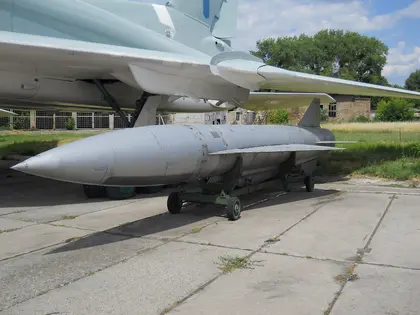Since the launch of the full-scale invasion, Russian forces have fired around 300 Kh-22 missiles (also called X-22 in English) at Ukraine, none of which have been intercepted and shot down, a Kyiv official said on Friday.
Speaking just hours after a massive attack on cities across Ukraine, Air Force spokesperson Yuriy Ihnat said this and a modified version of the rocket were likely some of those that made it past air defenses today.
JOIN US ON TELEGRAM
Follow our coverage of the war on the @Kyivpost_official.
So far 16 people are known to have been killed in today’s attack and a further 97 injured.
“The Kh-22 missile flies at a speed of four thousand kilometers per hour, it enters its target mostly along a ballistic trajectory, so special means are needed to intercept it,” he told national television.
“We need air defense systems like Patriot, so it's not so easy with these missiles. The enemy has used more than 300 of these missiles since the full-scale invasion.
“In addition to the Kh-22, they also have a modernized version of this missile – the Kh-32.
“Probably, these missiles were also used today.”
When asked what percentage of Kh-22/Kh-32 Ukraine’s air defenses had managed to shoot down, Ihnat said none, adding Russian forces use these types of missiles mainly on the southern and eastern directions, as well as in the north.
What is the Kh-22 and why is it so hard to shoot down?
The Kh-22 "Burya" (Storm) is a Soviet-era long-range airborne supersonic cruise missile.

Zelensky Meets CIA Director William Burns in Ukraine
Armed with a nuclear or highly explosive fragmenting cumulative warhead, it was initially designed to destroy aircraft carriers and other large warships, or even groups of such carriers.
The Kh-22 family was developed in the USSR in the 1960s and specifically designed to be launched from Tupolev-22 bombers.
Later, both the missiles and the aircraft were modernized as part of the so-called "Kh-22 special air-to-surface missile complex."
Upgraded in the 1970s, the missile had an impressive speed of 4,000 kilometers per hour, a 1,000-kilogram warhead and a range of 500 kilometers.
Few missiles in the world could compete with the Kh-22 at that time. Flight and firing tests of the Кh-22 complex were completed in 1967.
In 1975, as an alternative launching platform, the Tupolev-95К-22 was made to carry three Kh-22 missiles.
In the second half of the 1970s, Kh-22 missiles began to arm modernized supersonic Tupolev-22М2 and Tupolev-22М3 bombers that could also carry up to three missiles.
However, for striking purposes, they carry one or two missiles while three are attached only for transportation.
It should be noted that an Kh-22 missile weighs 5,820 kilograms. A total of approximately 3,000 such missiles were produced in the USSR.
After the USSR collapsed, quite a few of them remained in Ukraine. However, soon after independence in 1991, Ukraine gave up its nuclear and strategic aviation arsenal.
In 2000, Ukraine transferred 386 Kh-22 missiles to Russia as an instalment against the gas debt.
After Russia unleashed a full-scale invasion against Ukraine in February 2022, these missiles were used to commit numerous war crimes against Ukrainian civilians, including the strikes on the Riviera shopping mall in Kremenchuk, Poltava region, and an apartment building in Serhiivka, Odesa region.
On Jan. 14, 2023, an Kh-22 missile struck a nine-story apartment building in Dnipro that housed more than 1,100 people.
One of the 18 sections collapsed to rubble and the rest were partly destroyed or otherwise seriously damaged. Forty-six people died.
According to the Prosecutor General's Office, this type of weapon "causes the heaviest civilian casualties due to its extremely low precision.
Therefore, the use of this weapon against densely populated localities definitely constitutes a war crime."
The latest modifications of the Kh-22 have an inertial targeting system and a broader purpose range.
The Kh-22НА, for example, does not use a radar to find and lock a target but has an autopilot that steers it toward certain coordinates at a certain altitude depending on surface geometry.
Still, the Kh-22НА is rather old and vulnerable to Western antimissile weapons. The longer the launch-target distance, the lower precision and the easier interception.
The less time the missile is in the air, the more difficult it is to shoot it down. Just to compare: Kalibr cruise missiles that Russia launches from the Black Sea have a longer range but take longer to reach the target.
Their cruise speed is three times slower than that of the Kh-22, so it is easier to shoot them down.
You can also highlight the text and press Ctrl + Enter







